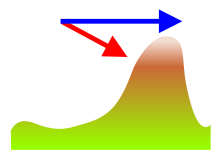
In aviation, a terrain awareness and warning system (TAWS) is generally an on-board system aimed at preventing unintentional impacts with the ground, termed "controlled flight into terrain" accidents, or CFIT.[1] The specific systems currently in use are the ground proximity warning system (GPWS) and the enhanced ground proximity warning system (EGPWS).[1] The U.S. Federal Aviation Administration (FAA) introduced the generic term TAWS to encompass all terrain-avoidance systems that meet the relevant FAA standards, which include GPWS, EGPWS and any future system that might replace them.[1]
As of 2007, 5% of the world's commercial airlines still lacked a TAWS.[2] A study by the International Air Transport Association examined 51 accidents and incidents and found that pilots did not adequately respond to a TAWS warning in 47% of cases.[3]
Several factors can still place aircraft at risk for CFIT accidents: older TAWS systems, deactivation of the EGPWS system, or ignoring TAWS warnings when an airport is not in the TAWS database.[4]
- ^ a b c Federal Aviation Administration, Installation of Terrain Awareness and Warning System (TAWS) Approved for Part 23 Airplanes Archived January 19, 2016, at the Wayback Machine, 14 June 2000
- ^ "Forecasts 2009 – Safety and security are in the doldrums". Flight International. Retrieved January 27, 2020.
- ^ "Section 10 - Ground Proximity Warning System (GPWS) / Terrain Awareness and Warning System (TAWS)". IATA Controlled Flight Into Terrain Accident Analysis Report (2008-2017 Data) (PDF) (Report). International Air Transport Association. 2018. p. 25. Archived (PDF) from the original on January 27, 2020. Retrieved January 27, 2020.
- ^ fika (April 27, 2010). ""Lotniska w Smoleńsku mogło nie być w bazie GPWS" – Polska – Informacje – portal TVN24.pl – 27.04.2010". Tvn24.pl. Retrieved October 18, 2011.